Let me guess—bedtime at your house looks something like this: You’re exhausted, your kid is bouncing off the walls, and you’re both dreading the nightly battle that’s about to unfold. I’ve been there. We’ve all been there.
Here’s the thing though—most kids actually love bedtime stories. In fact, Ipsos research shows that nearly half of American kids aged 7 or younger read bedtime stories before sleep, making it the most popular pre-bedtime activity. I still remember the magic of those quiet moments when my grandmother would read “Goodnight Moon” to me, her voice growing softer with each page turn. That ritual didn’t just help me fall asleep—it shaped my love for stories and created some of my most treasured childhood memories.
Look, I get it. Between work, dinner, baths, and everything else, finding time for a peaceful bedtime story can feel impossible. Plus, with screens everywhere and kids who seem to have endless energy, creating that calm bedtime atmosphere feels harder than ever.
But here’s what I’ve learned after years of working with families: the right story at the right time really can transform your child’s relationship with sleep. And understanding the basics of what makes a good story work—like the principles behind how to write a story using brain science—can help you figure out why some books work magic while others leave your kid wired and ready to party.
I’ve put together 32 stories that actually work, plus some real talk about what to look for when you’re building your own bedtime library.
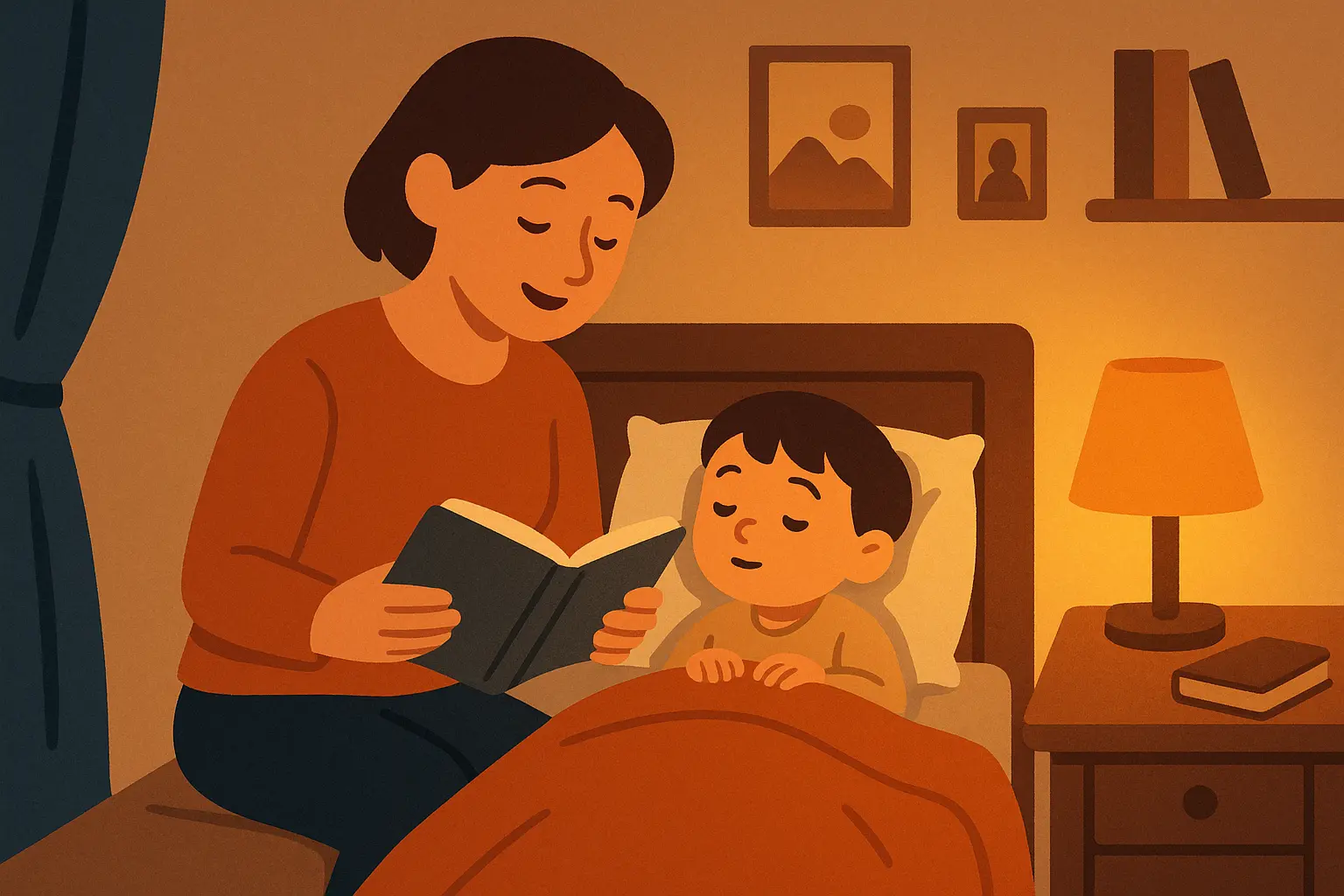
Table of Contents
-
What Makes a Good Bedtime Story (Spoiler: It’s Not What You Think)
-
The Classics That Never Get Old (Stories 1-5)
-
New Books That Really Work (Stories 6-9)
-
Animal Stories (Always a Hit) (Stories 10-13)
-
Books Where Kids Can Participate (Stories 14-17)
-
Stories All About Going to Sleep (Stories 18-21)
-
Story Collections for Busy Nights (Stories 22-25)
-
Stories That Show Different Families (Stories 26-29)
-
Learning Stories That Won’t Wire Your Kid (Stories 30-32)
-
What Actually Works: A Reality Check on Story Categories
-
Picking the Right Story for Tough Situations
-
Making Your Own Stories (Yes, Really)
The Quick Version
-
Keep it short (5-15 minutes), age-appropriate, and calm—no scary stuff or high-energy adventures right before sleep
-
Classic stories work because kids know what’s coming, and predictability is comforting at bedtime
-
Interactive books can be great if they’re gentle—think touching soft textures, not jumping around
-
Diverse stories help all kids see themselves in books while keeping that cozy bedtime feeling
-
Educational stories are fine as long as they’re not too stimulating—save the exciting science experiments for daytime
-
Story collections are lifesavers when you need flexibility for different moods and time constraints
-
You can actually create custom stories now using AI tools, which is pretty cool for addressing specific fears or interests
What Makes a Good Bedtime Story (Spoiler: It’s Not What You Think)
After working with countless families, I’ve figured out what actually makes bedtime stories work. It’s not about having the most beautiful illustrations or the most educational content—though those things are nice. It’s about finding that sweet spot where your kid is engaged enough to focus but calm enough to wind down.
The best bedtime stories share some key things: they’re the right length for your kid’s attention span, they’re soothing rather than exciting, they sneak in some learning without feeling like school, they have comforting repetition (yes, reading the same book 47 nights in a row is totally normal), they let kids participate just enough without getting them riled up, and they reflect your family’s world in some way.
Understanding what makes stories work can help you pick better books. If you want to dive deeper into this, checking out proven bedtime stories that parents love gives you a good sense of what consistently works for families.
|
Age Group |
Story Length |
What Works |
Good Themes |
|---|---|---|---|
|
2-3 years |
3-8 minutes |
Simple words, lots of repetition, things they recognize |
Daily routines, animal sounds, basic feelings |
|
4-5 years |
5-12 minutes |
Emotional stuff, longer stories, mild adventure |
Friends, family, dealing with fears |
|
6-8 years |
8-15 minutes |
Character growth, problem-solving, different perspectives |
Who they are, community, learning new things |
Getting the Age Thing Right
Your kid’s actual developmental stage matters more than the age on the book cover. Two-year-olds love simple words, concrete things they can point to, and familiar stuff from their world. I’ve watched countless toddlers get excited just seeing a ball or teddy bear in a story.
Preschoolers can handle bigger emotions and longer stories, while early elementary kids like characters who grow and change, plus mild adventures that feel safe. Think about sentence length too—short sentences work better for younger kids, while older ones can follow more complex descriptions. And make sure the emotional stuff matches what your kid can handle without getting anxious or confused.
Getting the Length and Pace Right
Most good bedtime stories take 5-15 minutes to read, but honestly, this varies by kid and situation. Too short and your child might want more stimulation; too long and you either lose their attention or get them too engaged to sleep.
The pace matters as much as the length. Stories with gentle, steady rhythms naturally help racing minds slow down. Skip anything with rapid scene changes, sudden plot twists, or high-energy sequences that might pump up your kid instead of calming them down.
Here’s a real example: When 4-year-old Emma started having nightmares, her mom Sarah switched from exciting adventure stories to gentler ones. The calmer content helped Emma think of bedtime as safe and secure rather than stimulating, and her sleep got better within two weeks of this simple change.
Content That Actually Calms Kids Down
The best bedtime stories create a peaceful feeling through their themes, pictures, and emotional tone. Look for cozy settings, gentle characters, and happy endings. Nature scenes, quiet home activities, and loving family moments usually work well.
Stay away from scary stuff, intense conflicts, or emotionally charged situations that might trigger anxiety or excitement. Even mildly suspenseful moments should resolve quickly and positively to keep that calm atmosphere.
Learning That Doesn’t Feel Like School
Good bedtime stories often teach things without feeling preachy or academic. They might introduce new words, practice counting, explore feelings, or show problem-solving through what the characters do. The educational stuff should feel natural to the story rather than forced. Kids absorb these lessons better when they’re engaged with characters and situations rather than getting direct instruction.
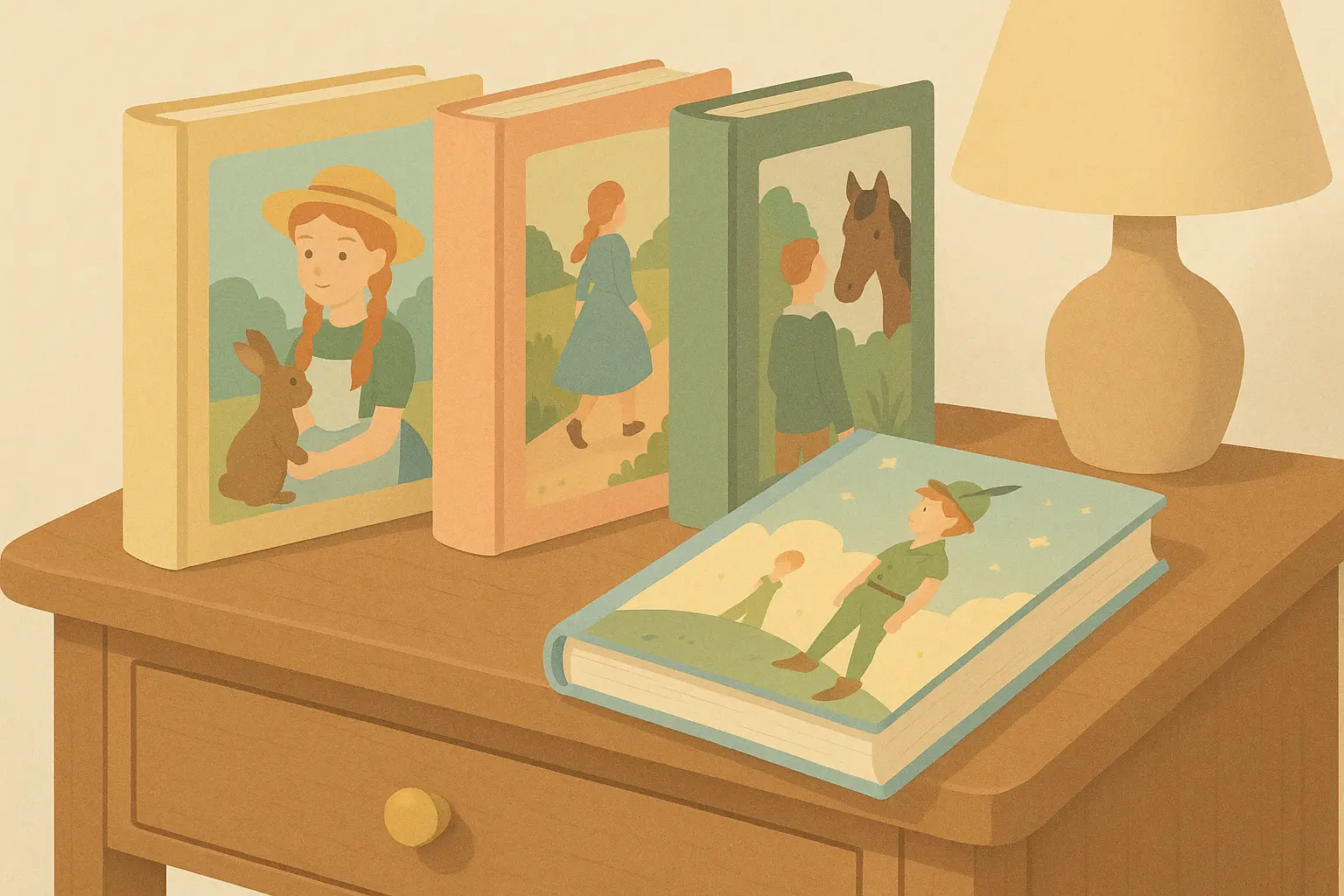
The Classics That Never Get Old
These timeless stories have stuck around because they combine familiar story patterns with universal themes that comfort kids across generations. Classic bedtime stories usually have predictable patterns, gentle adventures that end safely, and characters who find security and love. The repetitive parts and satisfying endings make them perfect for peaceful bedtime routines.
Classic tales draw from centuries of storytelling tradition, and understanding folktale story examples can help you appreciate why these stories have such lasting power for bedtime routines. I’ve seen these good bedtime stories work magic with kids who initially fight sleep time.
1. Goodnight Moon by Margaret Wise Brown
You know “Goodnight Moon”—it’s the one where the little bunny says goodnight to literally everything in his room. Sounds boring, but somehow it works like magic.
The repetitive structure feels like a ritual that mirrors actual bedtime routines, while the gradually darkening pictures visually show the transition toward sleep. The simple, rhythmic text uses familiar household objects that kids recognize from their own bedrooms, creating instant connection and comfort. Each page turn brings the room closer to darkness, naturally preparing young minds for their own journey into sleep.
2. The Very Hungry Caterpillar by Eric Carle
A caterpillar’s transformation combines counting practice, days of the week, and healthy eating concepts in a circular story structure. The predictable progression from egg to butterfly gives kids that satisfying closure they find both educational and emotionally comforting.
The gentle pace and colorful pictures engage visual learners while the transformation theme reassures kids about growth and change. The caterpillar’s final rest in his cocoon creates perfect bedtime imagery. Yes, you’ll probably end up memorizing this one. Yes, you’ll find yourself reciting it in the grocery store. This is normal parent behavior.
3. Where the Wild Things Are by Maurice Sendak
Max’s imaginary adventure lets kids explore feelings of anger and rebellion within a completely safe framework. The story acknowledges difficult emotions while ultimately emphasizing the security and comfort of home and family love.
The return to “his very own room where he found his supper waiting for him and it was still warm” provides the perfect bedtime message—no matter how far imagination might wander, home remains a safe, loving place. Fair warning: some kids find this one a little too exciting for bedtime. Know your kid. If they’re the type to want to BE a Wild Thing after hearing this story, maybe save it for afternoon reading.
4. The Runaway Bunny by Margaret Wise Brown
This story directly addresses separation anxiety through a mother bunny’s loving promises to always find her child, no matter how far he might wander. Each imagined escape scenario gets a gentle, creative response that shows unconditional parental love. The back-and-forth dialogue engages kids while the consistent message of unwavering love provides deep emotional security. The final image of the little bunny deciding to stay home reinforces the safety and comfort of family bonds.
5. Corduroy by Don Freeman
A toy bear’s gentle adventure in a department store and his eventual adoption by a loving child creates themes of belonging, acceptance, and finding home. The story validates feelings of being different while showing how love transcends imperfections.
The department store setting provides mild adventure without real danger, while Corduroy’s simple desire for friendship and belonging resonates with kids’ own social and emotional needs. Not every story works for every kid though—my neighbor’s daughter was terrified of “Corduroy” for some reason. Sometimes kids surprise you with what they find scary or boring.
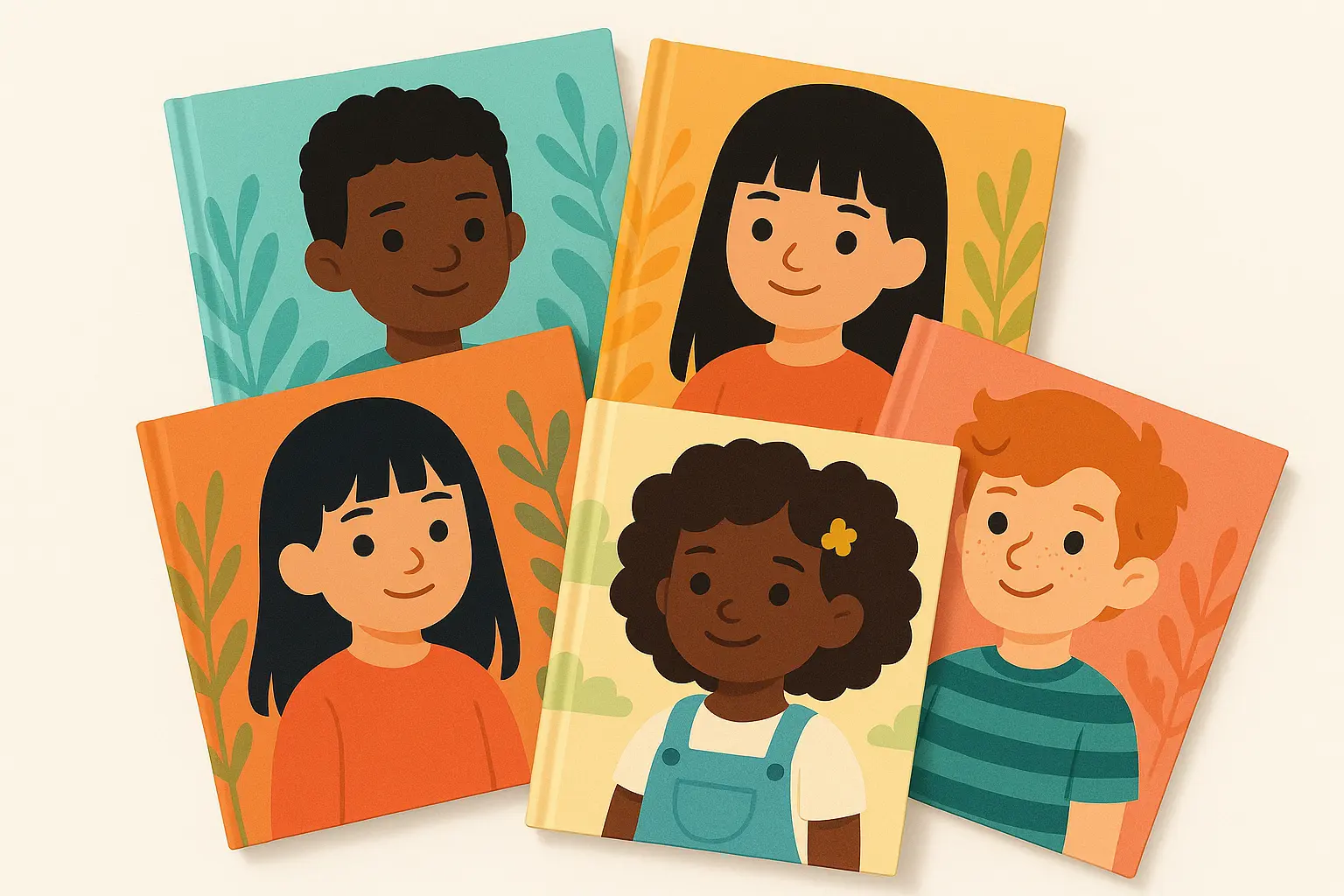
New Books That Really Work
Contemporary bedtime stories often tackle current childhood experiences and emotions with sophisticated understanding of child psychology. These books handle modern concerns while keeping the gentle, reassuring tone essential for bedtime reading. They often offer practical coping strategies wrapped up in engaging stories.
I’ve found that modern bedtime stories really connect with kids facing contemporary challenges. These bedtime story picks provide both comfort and practical guidance for today’s families.
6. The Kissing Hand by Audrey Penn
A mother raccoon helps her anxious child feel secure about starting school by placing a kiss in his palm that he can access whenever he needs comfort. This story gives kids a concrete strategy they can actually use during separations from parents.
The woodland setting creates a cozy, natural atmosphere while the practical solution addresses real childhood fears. Many families adopt the “kissing hand” technique as part of their own separation routines, making this story both comforting and actually helpful. Trust me on this one—if your kid is going through a tough time, “The Kissing Hand” is like a warm hug in book form.
7. Llama Llama Red Pajama by Anna Dewdney
Baby Llama’s bedtime anxieties and his mother’s patient, loving responses directly mirror common bedtime struggles in many households. The rhyming text creates a soothing rhythm while validating kids’ fears about being alone at bedtime.
The story shows how parents can respond to bedtime resistance with understanding rather than frustration, modeling healthy emotional communication. The resolution emphasizes security and love without dismissing the child’s genuine concerns.
8. The Way Back Home by Oliver Jeffers
A boy’s unexpected space adventure and his friendship with a stranded alien combines excitement with themes of helping others and finding your way home safely. The story balances adventure with reassurance about returning to familiar, safe places. The simple illustrations and straightforward narrative make complex themes accessible while the emphasis on friendship and helping others provides positive social modeling. The safe return home reinforces bedtime themes of security and belonging.
9. Dragons Love Tacos by Adam Rubin
This funny tale about dragons’ love for tacos (but not spicy salsa) uses absurd humor that kids find delightful without creating overstimulation. The silly premise keeps kids engaged while the gentle pace supports bedtime preparation.
The story’s playful tone and ridiculous situations encourage laughter and joy while avoiding any scary dragon stereotypes. The focus on food preferences and party planning creates familiar, domestic themes despite the fantastical characters.
Animal Stories (Always a Hit)
Animal characters and natural settings have universal appeal while addressing fundamental childhood experiences. These stories often use the natural world’s inherent peacefulness to promote calm feelings, while animal families provide non-threatening ways to explore human emotions and relationships.
I’ve noticed that bedtime stories featuring animals and nature consistently help kids feel more connected to the peaceful rhythms of the natural world. These bedtime story options work particularly well for kids who love animals or spend time outdoors.
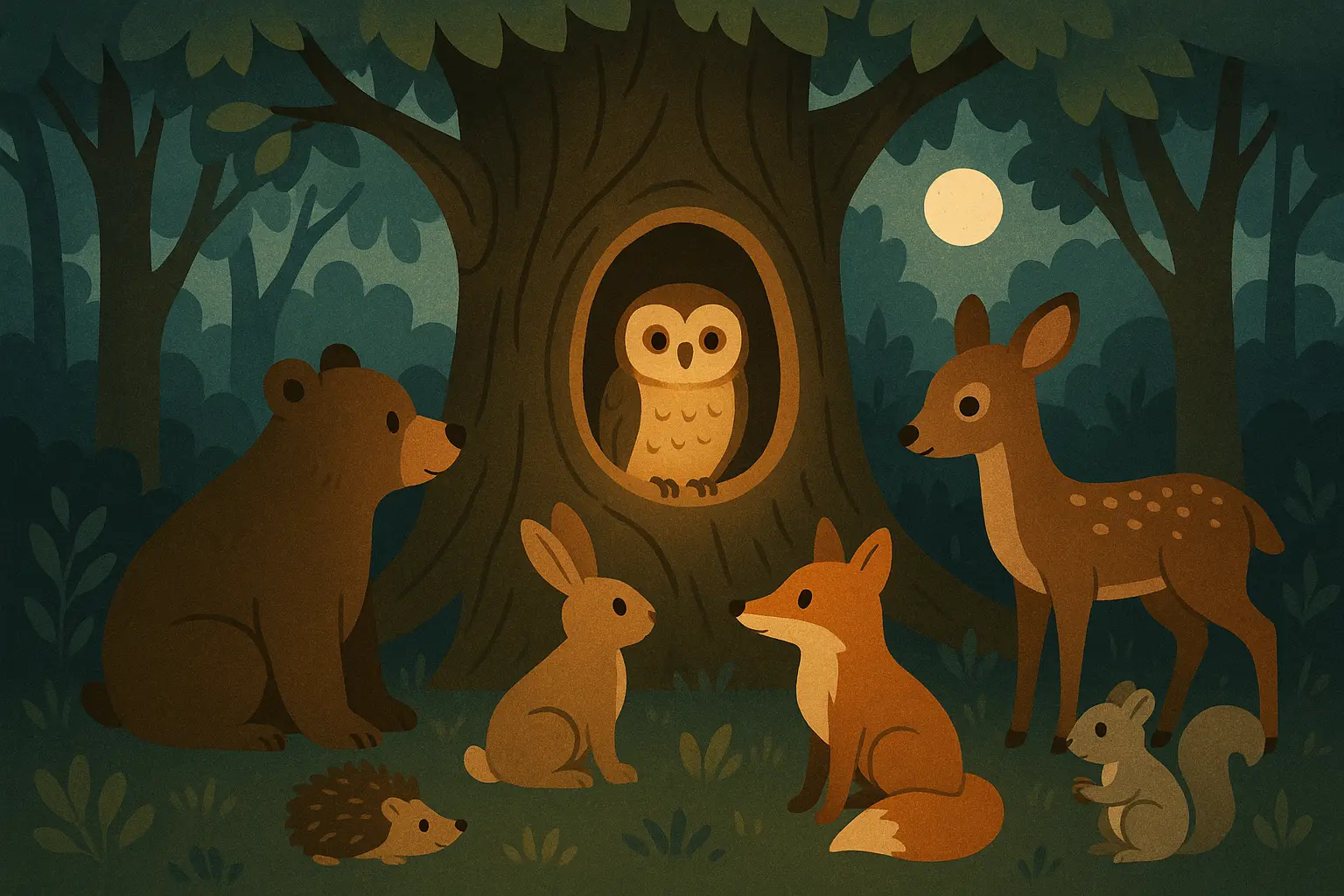
10. Owl Babies by Martin Waddell
Three baby owls wait
Three baby owls wait for their mother to return, each expressing different emotional responses to her absence. The story validates various ways kids might react to separation while providing reassurance through the mother’s eventual return.
The forest setting creates a cozy, natural atmosphere while the sibling relationships show how family members can comfort each other during difficult times. The repetitive phrase “I want my mommy” acknowledges kids’ genuine feelings without judgment.
11. The Sleepy Little Alphabet by Judy Sierra
Letters of the alphabet prepare for bed in this gentle combination of literacy learning and bedtime themes. Each letter participates in quiet, sleepy activities that reinforce both letter recognition and bedtime routines. The personification of letters makes abstract concepts concrete and relatable while the consistent bedtime theme creates appropriate sleepy associations with learning. The rhythmic text supports the calming bedtime atmosphere.
12. Time for Bed by Mem Fox
Various animal families tuck their babies into bed with rhythmic, repetitive text that sounds like lullaby patterns. The parallel structure across different animal species creates a universal bedtime experience that feels both familiar and comforting.
The gentle rhymes and consistent “time for bed” refrain naturally slow reading pace while the loving parent-child interactions in each animal family reinforce security and care. The progression through different animals keeps interest without excitement.
13. Bear Snores On by Karma Wilson
A sleeping bear’s den becomes a cozy gathering place for forest animals seeking warmth during winter. The story creates themes of community, sharing, and the comfort of sleep while maintaining a peaceful, hibernation atmosphere.
The repetitive refrain and cumulative structure provide predictability while the emphasis on warmth, coziness, and rest directly supports bedtime feelings. The bear’s continued sleeping throughout most of the story reinforces positive sleep associations.
Books Where Kids Can Participate
These stories engage kids through things they can touch, predictable text patterns, or gentle participation opportunities while keeping the calm atmosphere essential for bedtime. The interaction helps maintain attention during wind-down time without creating overstimulation, often building literacy skills through repetition and pattern recognition.
Three-year-old Marcus fought bedtime until his dad introduced “Pat the Bunny.” The tactile elements kept Marcus engaged while the gentle activities naturally calmed him down. After two weeks of incorporating touch-based stories, Marcus began asking for “the soft book” and would settle into reading time more willingly, completely changing their previously stressful bedtime routine.
I’ve discovered that the right interactive bedtime story can bridge the gap between active play and quiet rest time. These bedtime stories work especially well for kids who need sensory engagement to focus.
14. Pat the Bunny by Dorothy Kunhardt
This classic tactile book engages multiple senses through touch while keeping a calm, gentle pace perfect for quiet bedtime interaction. Kids can feel the bunny’s fur, smell flowers, and play peek-a-boo within a structured, predictable format.
The physical interaction satisfies kids’ need for sensory engagement while the simple activities and soft textures promote relaxation rather than excitement. The book’s small size and sturdy construction make it perfect for bedtime handling.
15. Dear Zoo by Rod Campbell
A lift-the-flap book about finding the perfect pet provides just enough interaction to keep kids engaged without creating excitement. The predictable structure lets kids anticipate what’s coming while still enjoying the surprise of each reveal. The repetitive text pattern lets kids participate in “reading” while the gentle humor and familiar animals create comfort and security. The satisfying conclusion with the perfect puppy provides closure and contentment.
16. Brown Bear, Brown Bear, What Do You See? by Bill Martin Jr.
The repetitive, predictable text lets kids participate by “reading” along or filling in familiar phrases, building literacy confidence while keeping a soothing rhythm. The pattern becomes so familiar that kids can recite portions independently.
The colorful animal illustrations engage visual interest while the consistent question-and-answer format creates security through predictability. The circular structure brings the story back to the beginning, providing satisfying closure.
17. Chicka Chicka Boom Boom by Bill Martin Jr.
Alphabet letters climb a coconut tree in this rhythmic story that combines letter recognition with engaging but not overly exciting adventure. The musical quality of the text makes it naturally soothing while building literacy skills.
The tree-climbing adventure provides just enough action to keep interest while the emphasis on letters working together creates positive learning associations. The resolution with letters helping each other reinforces cooperation and care.

Stories All About Going to Sleep
These stories directly tackle bedtime routines, sleep preparation, and nighttime themes, making them particularly effective for creating positive sleep associations. They often mirror kids’ actual bedtime experiences while adding elements of comfort, security, and gentle humor that make the transition to sleep more appealing and less anxiety-provoking.
When you’re dealing with bedtime resistance, these bedtime stories can be game-changers. I’ve watched families completely transform their evening routines by incorporating stories that celebrate sleep and rest rather than treating bedtime as an interruption to fun.
18. The Going to Bed Book by Sandra Boynton
Animals on a boat go through their bedtime routine, mirroring the activities kids do before sleep while adding a gentle adventure element. The story makes bedtime feel familiar and structured while keeping a playful, engaging tone.
The boat setting adds mild adventure without disrupting the calming progression through typical bedtime activities. Brushing teeth, putting on pajamas, and settling down for sleep become part of a shared community experience. The group participation makes bedtime feel social and fun rather than isolating.
19. Bedtime for Frances by Russell Hoban
A young badger’s bedtime stalling tactics and her parents’ patient responses help kids process their own bedtime resistance in a humorous, understanding way. The story validates kids’ bedtime concerns while showing healthy family communication.
Frances’s various excuses and worries mirror common childhood bedtime behaviors, while her parents’ gentle but firm responses provide modeling for both kids and parents. The resolution emphasizes security and love within appropriate boundaries.
20. The Napping House by Audrey Wood
A cumulative story about everyone and everything piling onto a bed for a nap creates a cozy, communal atmosphere that makes sleep seem appealing and social. The repetitive structure builds anticipation while keeping a sleepy, peaceful tone. The gradual addition of sleepy characters creates a hypnotic rhythm while the emphasis on rest and comfort directly supports bedtime themes. The illustrations grow progressively more peaceful and sleepy throughout the story.
21. Ten, Nine, Eight by Molly Bang
A countdown bedtime story follows a father and daughter’s bedtime routine while combining number learning with gentle, loving bedtime preparation. The decreasing numbers naturally create a winding-down feeling that mirrors the approach of sleep.
The warm family interaction and familiar bedtime activities create security and comfort while the counting element adds educational value. The progression toward zero parallels the progression toward sleep in a natural, soothing way.
Story Collections for Busy Nights
These collections offer flexibility for different bedtime needs, letting parents read one short story or multiple tales depending on time constraints and kids’ attention spans. The recurring characters and consistent gentle themes provide familiarity and comfort while offering variety within a predictable framework that supports bedtime routines.
Collections solve the problem of varying bedtime schedules and energy levels. Some nights you need a quick five-minute story, other evenings call for longer engagement. These bedtime stories for kids provide that adaptability while maintaining quality content.
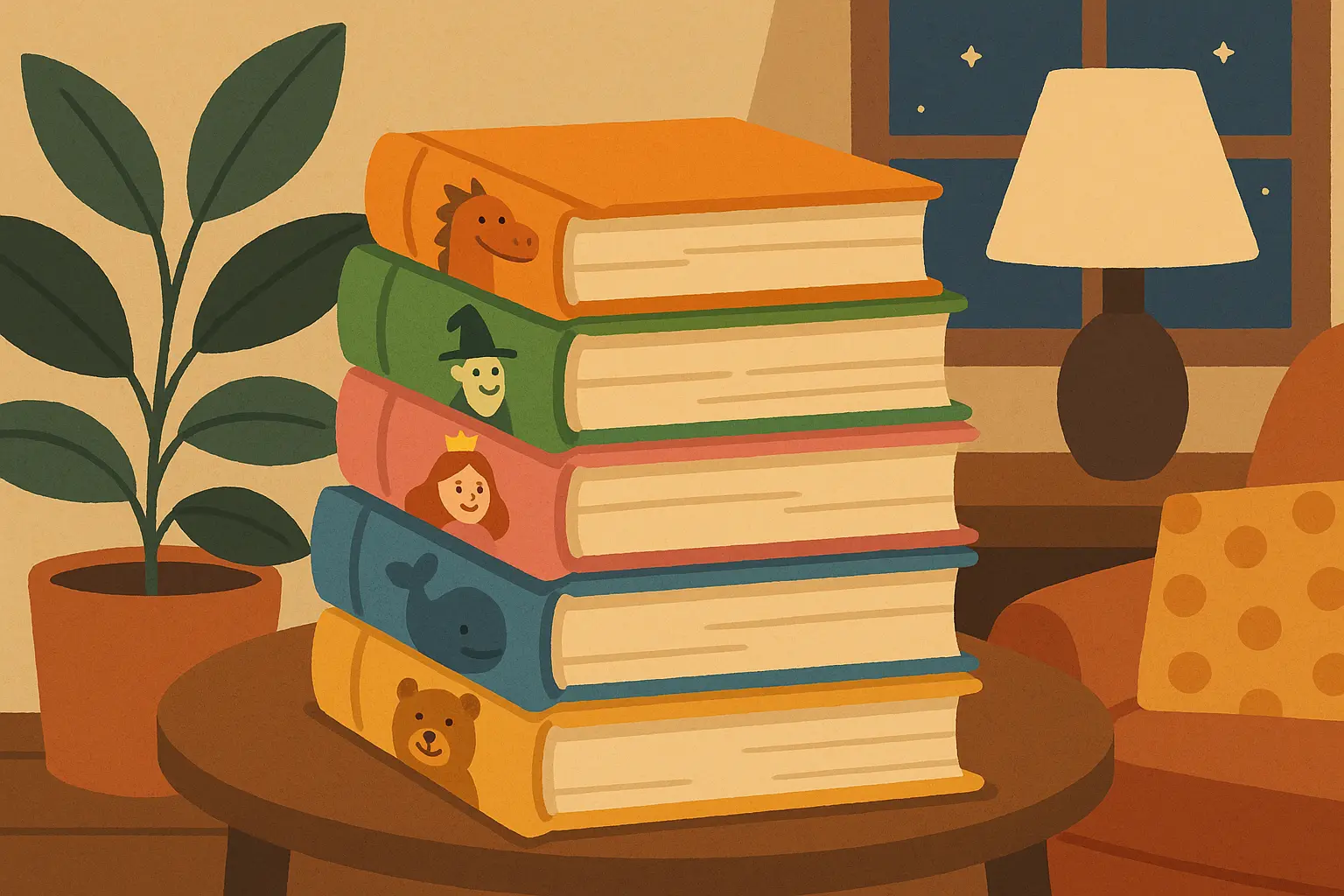
22. Frog and Toad Are Friends by Arnold Lobel
Five gentle stories about friendship between Frog and Toad provide heartwarming themes without overstimulation. Each story can stand alone or be read as part of the collection, offering flexibility for different bedtime situations and time constraints.
The simple language and familiar friendship dynamics create comfort and security while the gentle humor and problem-solving scenarios provide positive social modeling. The consistent characters become familiar friends that kids look forward to visiting.
23. Little Bear by Else Holmelund Minarik
Four short stories about Little Bear’s everyday adventures with his mother provide comfort through familiar family relationships and gentle humor. The domestic settings and loving parent-child interactions create security and warmth.
The simple sentence structure makes this collection accessible for emerging readers while the family themes resonate with kids’ own experiences. Little Bear’s relationship with his mother provides modeling for secure attachment and unconditional love.
24. The Stories Julian Tells by Ann Cameron
Six interconnected stories about a boy and his family offer slightly longer content for older kids while keeping gentle, family-centered themes. Julian’s everyday adventures and his relationships with his brother and parents create relatable scenarios that feel both familiar and engaging. The realistic family dynamics and mild childhood mischief provide entertainment without overstimulation, while the loving family relationships reinforce security and belonging. The stories address common childhood experiences including sibling relationships, creativity, and growing up.
25. Mercy Watson to the Rescue by Kate DiCamillo
The first in a series about a pig who thinks she’s a person offers gentle humor and mild adventure suitable for kids ready for chapter-style stories. Mercy’s domestic adventures with her loving owners create warmth and security within an entertaining framework.
The slightly longer format bridges picture books and early chapter books while keeping bedtime-appropriate content. The absurd premise and loving family relationships create comfort through humor and affection.
Stories That Show Different Families
These stories expand kids’ worldview while keeping the gentle, comforting qualities essential for bedtime reading. They provide windows into different cultural experiences and mirrors for kids from diverse backgrounds, helping all kids see themselves and others represented in literature while promoting understanding, empathy, and inclusion through age-appropriate narratives.
Representation matters deeply in bedtime stories. I’ve seen kids’ faces light up when they recognize their own experiences reflected in a bedtime story, and I’ve watched other kids develop genuine curiosity and respect for different ways of living through these bedtime stories for kids.
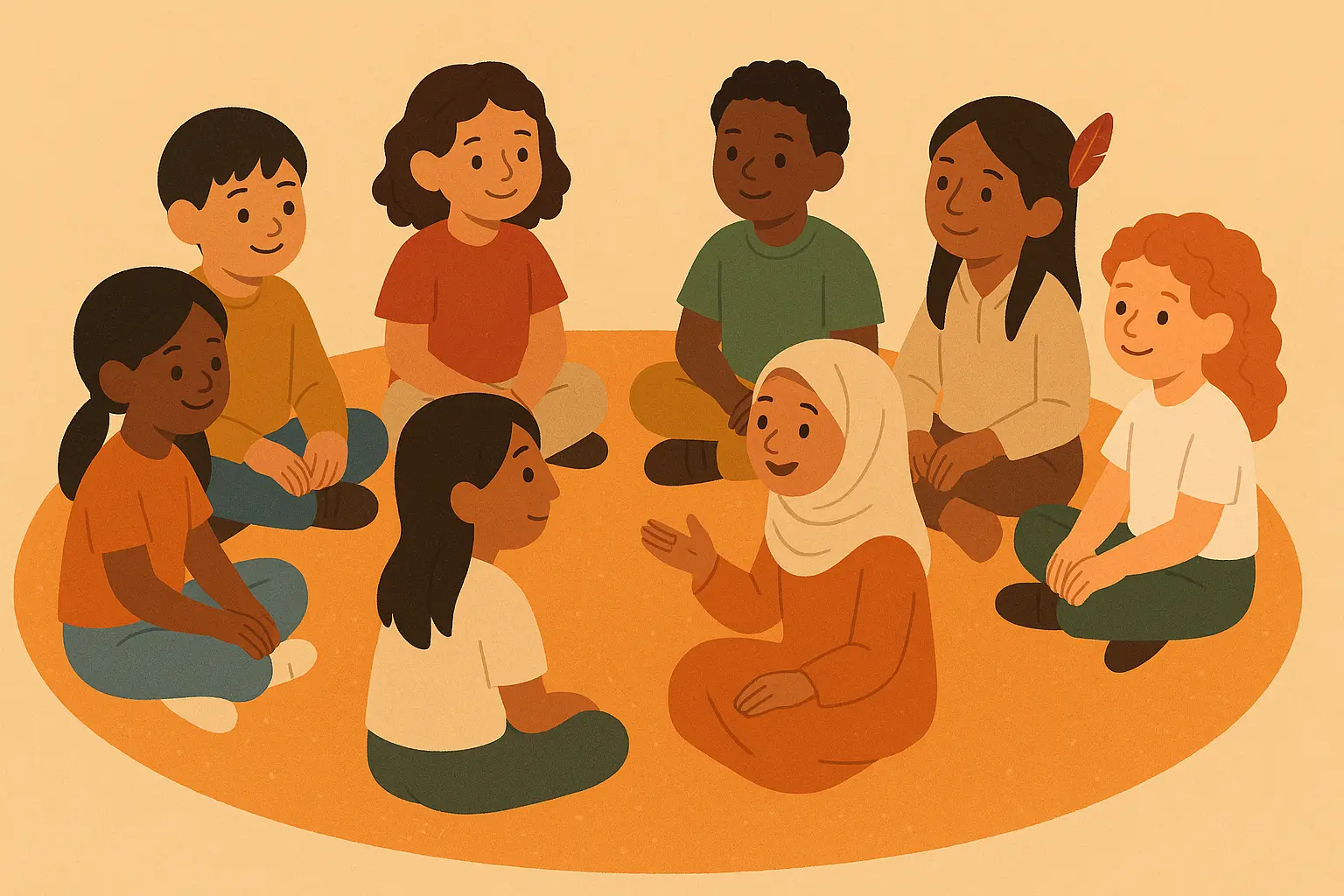
26. Last Stop on Market Street by Matt de la Peña
A young boy’s bus journey with his grandmother reveals beauty in everyday urban life while teaching appreciation for diversity and community. The intergenerational relationship and urban setting provide representation often missing from traditional bedtime stories.
The gentle pace and loving grandmother-grandson relationship create warmth and security while the themes of finding beauty in ordinary places promote positive perspectives. The public transportation setting feels familiar to many urban kids while remaining calm and non-threatening.
27. The Name Jar by Yangsook Choi
A Korean girl navigates starting school in America and deciding whether to choose an American name, addressing cultural identity with sensitivity and warmth. The story validates the immigrant experience while promoting acceptance and cultural pride. The school setting and identity themes resonate with many kids’ experiences while the gentle resolution emphasizes self-acceptance and cultural celebration. The supportive classmates and understanding teacher provide positive social modeling.
28. Crown: An Ode to the Fresh Cut by Derrick Barnes
A celebration of African American barbershop culture and self-confidence uses rhythmic text that’s engaging but soothing. The story builds positive self-image and cultural pride while keeping a calm, reflective tone perfect for bedtime.
The community setting and positive male relationships provide important representation while the themes of self-care and confidence support healthy identity development. The poetic language creates a gentle, affirming atmosphere.
29. Islandborn by Junot Díaz
A girl draws pictures of her homeland for a school project, exploring themes of memory, immigration, and belonging with beautiful illustrations and gentle storytelling. The story validates the immigrant experience while celebrating cultural heritage and family connections.
The artistic project framework provides structure while the memories and family stories create warmth and connection. The themes of belonging and cultural identity resonate with many kids’ experiences while remaining gentle and affirming.
Learning Stories That Won’t Wire Your Kid
These stories integrate science, technology, engineering, math, and creative thinking into bedtime-appropriate narratives that inspire curiosity and learning without overstimulation. They show that learning can be gentle, creative, and emotionally satisfying while building positive associations between education and comfort.
Educational content doesn’t have to be stimulating or energizing. The right bedtime story can plant seeds of curiosity while keeping the peaceful atmosphere essential for sleep preparation.
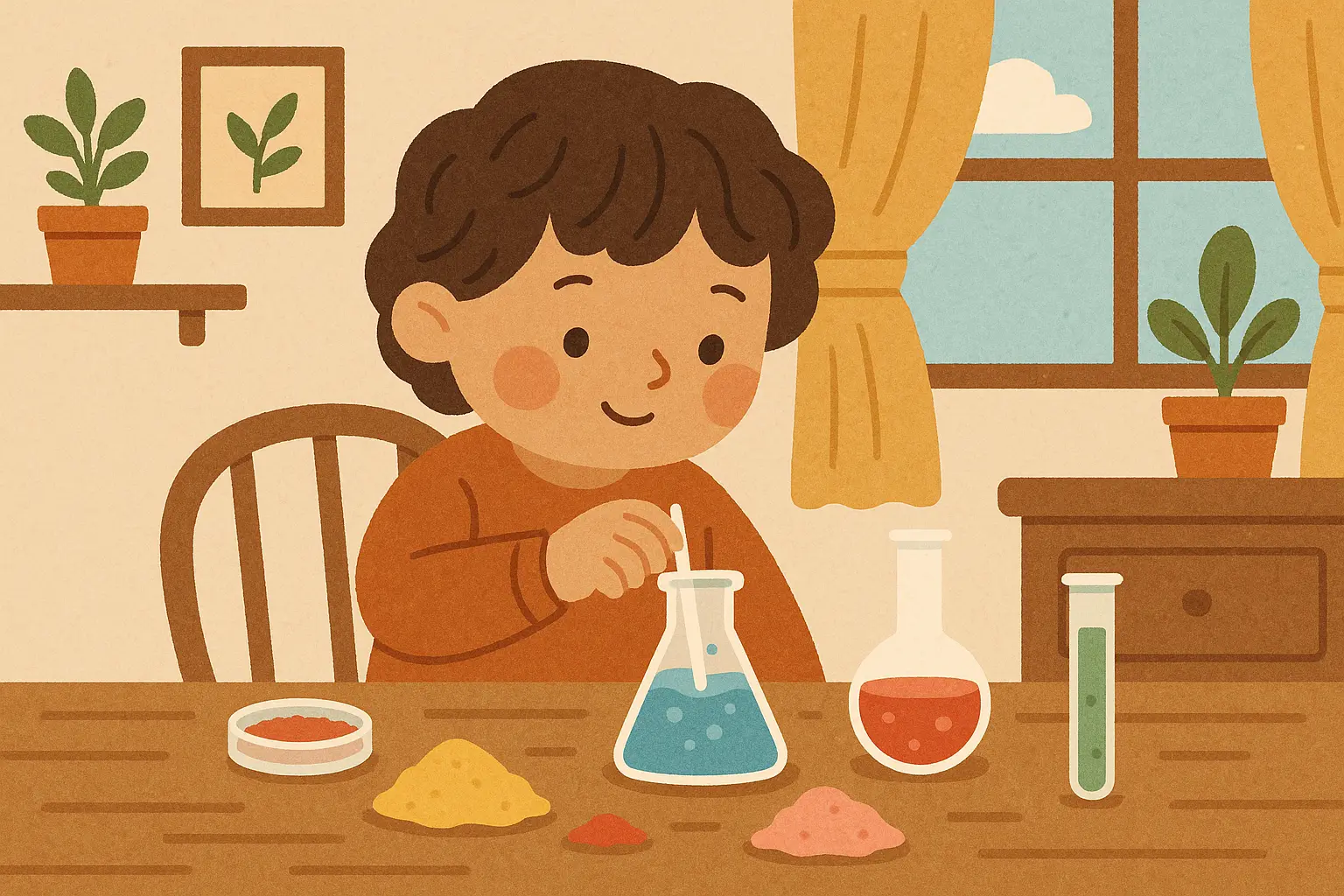
30. The Dot by Peter H. Reynolds
A story about creativity and self-confidence begins with a simple dot and grows into a celebration of artistic expression and personal growth. The gentle encouragement and creative process provide inspiration while keeping a calm, reflective tone.
The art classroom setting and supportive teacher relationship create positive learning associations while the themes of overcoming self-doubt and finding creative confidence support emotional development. The simple artistic progression from dot to masterpiece shows how small beginnings can lead to great achievements.
31. Rosie Revere, Engineer by Andrea Beaty
A young girl’s engineering dreams and perseverance through failure demonstrate problem-solving and resilience with gentle humor and encouraging messages. The story promotes STEM interests while emphasizing that mistakes are part of learning. The supportive family relationships and creative problem-solving provide positive modeling while the themes of persistence and innovation inspire without creating pressure. The rhyming text and whimsical inventions keep engagement while supporting bedtime calm.
32. The Important Book by Margaret Wise Brown
A poetic exploration of what makes various objects and concepts important uses repetitive structure and philosophical content that’s both soothing and thought-provoking. The book encourages reflection and appreciation for everyday things.
The consistent format provides predictability while the varied subjects keep interest without excitement. The philosophical approach to ordinary objects promotes mindfulness and gratitude while the gentle repetition supports relaxation.
What Actually Works: A Reality Check on Story Categories
Understanding how different story categories fulfill essential bedtime criteria helps parents make informed picks based on their kid’s specific needs, where they’re at developmentally, and their current emotional state. Each category offers unique benefits while keeping the fundamental characteristics that make bedtime stories effective for promoting calm, security, and healthy sleep associations.
I’ve analyzed hundreds of bedtime stories to understand what makes them work, and this breakdown will help you choose the right bedtime story for any situation your family faces.
|
Story Category |
What’s Great About Them |
Best For |
How Calming |
|---|---|---|---|
|
Classic Tales |
Familiar, predictable patterns |
All ages, building routines |
Very calming |
|
Modern Themes |
Current relevance, emotional support |
Ages 4-8, specific challenges |
Pretty calming |
|
Nature/Animal |
Universal appeal, gentle themes |
Ages 2-6, nature lovers |
Very calming |
|
Interactive |
Engagement without overstimulation |
Ages 2-5, active kids |
Somewhat calming |
|
Sleep-Specific |
Direct sleep association |
All ages, bedtime resistance |
Extremely calming |
|
Collections |
Flexibility, variety |
All ages, varying schedules |
Depends on story |
|
Different Families |
Representation, worldview expansion |
Ages 4-8, diverse families |
Pretty calming |
|
STEM Learning |
Education with comfort |
Ages 5-8, curious minds |
Somewhat calming |
What Works for Different Ages
Stories for ages 2-4 focus on simple words, repetitive structures, and familiar concepts that match toddlers’ developmental needs. Books with concrete imagery and predictable patterns work best because young kids can follow and anticipate the story flow.
Ages 4-6 benefit from stories addressing emotional development and growing independence while keeping comforting themes. These kids can process more complex feelings about separation, sleep, and growing up when presented within secure, loving contexts.
Kids ages 6-8 can handle more complex narratives and character development while still needing gentle, family-friendly content. Story collections and diverse narratives provide longer engagement without overstimulation, while expanding their understanding of different experiences and perspectives.
How Length and Pace Really Matter
Short stories taking 5-10 minutes work perfectly for standard bedtime routines, providing enough engagement to create connection without extending bedtime unnecessarily. Most picture books fall into this category, offering complete narratives within manageable timeframes.
Medium-length stories requiring 10-15 minutes suit kids who enjoy longer bedtime interactions or families with more flexible schedules. These stories often provide deeper character development or more complex themes while keeping bedtime-appropriate pacing. Flexible-length collections let parents adapt to varying circumstances, reading one story when time is limited or multiple stories when kids need extra comfort or connection. This adaptability makes collections particularly valuable for busy families.
What Actually Calms Kids Down
Highly calming stories directly promote sleepiness through their themes, imagery, and gentle pacing. These work best for kids who struggle with bedtime transitions or high energy levels.
Moderately calming stories provide gentle adventure or emotional content that engages without overstimulating. These address real concerns while keeping security and comfort. Balanced engagement stories keep interest through humor, rhythm, or mild adventure while avoiding high-energy content, keeping kids engaged while supporting bedtime preparation.
Pro tip: If your kid gets attached to one particular story, just roll with it. Reading the same book 47 nights in a row won’t hurt anyone, and fighting it will just make bedtime harder.
Picking the Right Story for Tough Situations
Strategic story selection can address specific childhood challenges, support developmental transitions, and enhance the bedtime routine’s effectiveness for different family situations. Understanding how to match stories to circumstances helps parents use bedtime reading as a tool for emotional support, learning reinforcement, and relationship building while keeping the primary goal of peaceful sleep preparation.
When developing custom bedtime narratives, understanding story theme examples can help parents create meaningful content that addresses their kid’s specific emotional needs while keeping bedtime-appropriate elements.
I’ve worked with families facing everything from divorce to moving to new siblings, and the right bedtime stories can provide incredible support during challenging times. These bedtime stories for kids become tools for processing difficult emotions safely.

Handling Specific Emotional Stuff
During major life transitions, pick stories that directly address these experiences. School anxiety responds beautifully to stories that normalize the experience while giving concrete coping strategies.
For kids experiencing separation anxiety, focus on stories that emphasize parental love and return. These narratives validate waiting feelings while providing reassurance through consistent messages of unconditional love and security.
When kids struggle with self-confidence or feeling different, stories that celebrate uniqueness while showing how differences can be strengths work wonders. These narratives build positive self-image while keeping bedtime calm.
Here’s a real example: When 5-year-old Aiden started kindergarten, bedtime became a struggle filled with worries about the next school day. His parents introduced “The Kissing Hand” and began giving him a real “kissing hand” each night. Within a month, Aiden was asking for his kissing hand and sleeping more peacefully, having internalized the story’s message of carrying parental love with him wherever he went.
Seasonal and Situational Changes
Winter months call for cozy stories that emphasize warmth and togetherness. Stories featuring hibernation imagery work perfectly, while tales building communal comfort match the season’s indoor focus.
Summer bedtime routines might benefit from nature stories that acknowledge longer daylight while still promoting sleep. Animal stories and gentle outdoor adventures can bridge the gap between active summer days and necessary rest. Holiday periods often disrupt routines, making familiar, comforting stories especially valuable. Return to tried-and-true favorites that provide stability during exciting but potentially overstimulating times.
Building Long-Term Reading Relationships
Start with a core collection of 8-10 versatile stories that work across different moods and situations. Include at least one story from each major category to provide variety while keeping bedtime-appropriate content.
Use a rotation system that introduces new stories gradually while preserving familiar favorites. This prevents boredom while keeping the comfort that comes from predictable, beloved narratives. Let kids participate in story selection from pre-approved options, giving them agency while ensuring all choices remain bedtime-suitable. This involvement increases engagement while teaching decision-making skills.
Making Your Own Stories (Yes, Really)
Modern AI tools offer unprecedented opportunities to create personalized bedtime content that addresses specific childhood needs, interests, and developmental stages while keeping all the essential characteristics of effective bedtime stories. This technology lets parents supplement traditional published stories with custom narratives tailored to their unique family situations and kids’ evolving needs.
Parents looking to create personalized content can use Nairrate’s bedtime story generator to craft custom narratives that address their kid’s specific interests and developmental needs while keeping the calming qualities essential for sleep preparation.
I’ve seen families create incredibly meaningful bedtime stories that address everything from pet loss to cultural traditions to specific fears. These custom bedtime stories become treasured family artifacts that speak directly to your kid’s heart.
|
What You Need a Story For |
What to Tell the AI |
What You’ll Get |
Best Age Range |
|---|---|---|---|
|
Fear of Dark |
“Gentle, cozy nighttime adventure, friendly moon character, warm lighting” |
Reframes darkness as comforting |
3-6 years |
|
New Sibling |
“Big brother/sister helps baby, family love grows, gentle cooperation” |
Reduces sibling jealousy |
2-5 years |
|
Moving Anxiety |
“Character finds new home cozy, makes friends, keeps special memories” |
Eases transition fears |
4-7 years |
|
School Worries |
“Character enjoys learning, makes friends, teacher is kind and helpful” |
Builds school confidence |
4-6 years |

Tackling Specific Bedtime Challenges
When kids struggle with particular fears or anxieties, custom stories can provide targeted support while keeping bedtime-appropriate content. Nairrate’s Story Generator can create narratives featuring characters who successfully navigate similar challenges, providing models for coping while ensuring gentle, reassuring outcomes.
For separation anxiety, generate stories about characters who learn to feel secure when apart from parents, incorporating specific strategies your family uses. Address fear of the dark by creating tales that reframe nighttime as cozy, safe, or magical without including scary elements.
Bedtime resistance often responds well to stories where characters discover the benefits and joys of sleep, rest, and bedtime routines. Custom narratives can make sleep seem appealing and necessary rather than something that interrupts fun activities.
Personalizing Content for Individual Interests
Kids’ specific fascinations—whether dinosaurs, space, cooking, or art—can be woven into bedtime stories that keep calming qualities while incorporating beloved themes. This personalization increases engagement while ensuring content remains sleep-appropriate.
For parents seeking inspiration for custom content, exploring short story examples can provide valuable insights into effective narrative structures that work well for bedtime storytelling.
Nairrate’s tools let parents specify gentle, educational elements that match their kid’s current learning goals. Create stories that reinforce letter recognition, number concepts, or social skills within entertaining narratives that support bedtime preparation. Family-specific elements including pets, relatives, or special traditions can be incorporated into custom stories, making bedtime reading feel more personal and relevant to your kid’s actual life experiences.
Keeping Quality Standards in Custom Stories
When generating custom bedtime content, specify gentle, calming themes in your prompts to ensure appropriate tone and pacing. Request age-appropriate vocabulary and sentence structures that match your kid’s developmental level and comprehension abilities.
Include specific elements such as repetitive phrases, predictable outcomes, or familiar settings that provide comfort and security. Emphasize positive, secure endings that promote feelings of safety and contentment before sleep.
The flexibility of AI-generated content allows for ongoing customization as kids grow and their needs change, providing fresh material while keeping the essential characteristics that make bedtime stories effective for promoting peaceful sleep and positive family connections.
Final Thoughts
Look, bedtime stories aren’t magic bullets. Some nights will still be rough. But having a few go-to books that you and your kid both actually enjoy? That makes those tough nights a little easier.
The tradition of bedtime stories represents far more than simple entertainment—it creates lasting bonds between parents and kids while supporting crucial developmental needs during the vulnerable transition to sleep. These 32 carefully selected stories provide a solid foundation for building meaningful bedtime routines that can adapt and grow with your family’s changing needs.
Remember that the most important element isn’t finding the “perfect” story, but rather creating consistent, loving moments of connection that help your kid feel secure and valued. Whether you choose classic tales that have comforted generations or explore modern stories that reflect today’s diverse world, the key lies in your presence, attention, and genuine engagement with your kid’s experience.
The bedtime story tradition faces real challenges in our fast-paced, technology-rich world, but its benefits—stronger vocabulary development, better emotional regulation, and deeper family bonds—make it worth preserving and protecting. By understanding what makes bedtime stories effective and having a diverse collection to draw from, you’re investing in your kid’s immediate comfort and long-term success.
For families interested in expanding their storytelling repertoire beyond traditional bedtime tales, exploring various story examples can provide inspiration for creating engaging narratives that maintain the gentle, calming qualities essential for bedtime success.
As your kids grow and their needs evolve, don’t hesitate to supplement traditional published stories with personalized content that speaks directly to their unique interests, fears, and developmental stages. The combination of time-tested classics and custom-created narratives can provide the perfect balance of familiarity and novelty that keeps bedtime reading fresh, engaging, and deeply meaningful for years to come.
Remember, you don’t need to be perfect at this. The fact that you’re here, looking for ways to make bedtime better for your kid, means you’re already doing great. Pick a story, snuggle up, and see what happens. Some nights you’ll nail the perfect bedtime story routine. Other nights, you’ll be so tired you’ll accidentally read the same page twice and your kid will correct you. Both are totally fine.
Start with one or two stories from this list, see what works, and build from there. You’ve got this.



Add comment